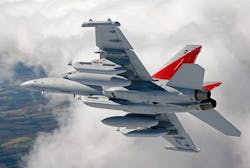Raytheon wins billion-dollar contract to build 15 NGJ airborne electronic warfare (EW) pods
Officials of the Naval Air Systems Command at Patuxent River Naval Air Station, Md., announced a $1 billion contract Wednesday to the Raytheon Co. to build and test 15 Next Generation Jammer (NGJ) aircraft-mounted pods in support of NGJ full-scale development.
The NGJ is a tactical electronic jammer pod that replaces the 40-plus-year ALQ-99 jammer system on the EA-18G -- a version of the Navy's carrier-based two-seat F/A-18F Super Hornet jet fighter-bomber that is modified specially for electronic warfare.
The EA-18G leads an airborne attack by disrupting enemy radar, communications, and computer networks with jamming signals and computer viruses. The aircraft also can destroy enemy radar installations with its AGM-88 High-speed Anti-Radiation Missiles (HARM).
Wednesday's contract to the Raytheon Space and Airborne Systems segment in El Segundo, Calif., also calls for Raytheon to build 14 NGJ aero-mechanical test pods to verify aircraft flying qualities and pod safe separation from the host aircraft; equipment for system integration laboratories; and mature manufacturing processes.
Coincidentally, the Boeing Co. Defense, Space & Security segment in St. Louis -- the EA-18G builder -- won a $19.9 million contract last week for aircraft modifications to the EA-18G are compatible for the NGJ program's engineering and manufacturing development stage.
Raytheon's NGJ will integrate the most advanced electronic attack technology into the EA-18G, such as high-powered, agile beam-jamming techniques, and solid-state electronics to deny, degrade and disrupt enemy threats while protecting U.S. and coalition forces.
Raytheon’s NGJ will provide airborne electronic attack and jamming capabilities, and will include cyber-attack capabilities that use the aircraft's active electronically scanned array (AESA) radar to insert tailored data streams into enemy radar and communications systems.
The NGJ also will have an open-systems architecture for future upgrades. Raytheon will use its gallium nitride (GaN)-based AESA technologies for the NGJ design.
Eventually Raytheon engineers may modify the NGJ to install it aboard the F-35 joint strike fighter, unmanned aerial vehicles (UAVs), as well as to other manned aircraft in addition to the EA-18G.
The goal of the NGJ technology-development phase is to develop an electronic attack system that will improve airborne electronic attack capabilities against advanced threats through enhanced agility and precision within jamming assignments, increased interoperability, and expanded broadband capability for greater threat coverage against a wide variety of radio frequency emitters, Navy officials say.
Raytheon won the job to design and build the NGJ in July 2013 over competitors ITT Exelis/Boeing, Northrop Grumman, and BAE Systems. Exelis now is part of Harris Corp.
The program quickly was held up for seven months because of a protest by BAE Systems, whose experts claimed the Navy improperly considered NGJ cost and technology proposals during the competition. The program resumed in early 2014.
On Wednesday's contract Raytheon will do the work in El Segundo, Calif.; Forrest, Miss.; Dallas.; McKinney, Texas.; Torrance, Calif.; Fort Wayne, Ind.; Marion, Va.; San Diego; Andover, Mass.; and Tucson, Ariz., and should be finished by December 2020.
For more information contact Raytheon Space and Airborne Systems online at www.raytheon.com, or Naval Air Systems Command at www.navair.navy.mil.
